This will be the final post for the 2013 Amazing Myanmar Photo Tour and I’d like to touch on two concepts that I try to instill upon participants during my photo tours. The first is “finding good light” and the second is “working the scene”. Each day, before each photo shoot, I stress the importance of selecting not only compelling subjects, but finding and photographing compelling subjects in good light. It doesn’t matter how beautiful or compelling your subject is if the lighting sucks, and although post-processing can do a lot to improve the look of a photo which was shot under less than perfect lighting conditions, it’s always preferable to find good light and try to “get it right in the camera” than to try to fix it later. The expression “you can’t polish a turd”, is indeed, quite apropos.
In fact, only when good subject matter and good lighting conditions come together at the same moment, do we have the opportunity to create truly beautiful images. But good subjects in good light don’t in and of themselves guarantee a great shot. Even when conditions are ideal, it often takes more than just one or two frames to get everything just right. Once a good subject in good light is found, then one must “work the scene”, choosing different lenses, perspectives and compositions.
Here’s a typical scenario which happens on day one of my tours…upon entering an interesting pagoda or market place, I walk past dozens of “good looking subjects” because those “good looking subjects” are in bad lighting conditions. I do this because I want to impress upon my tour guests that what catches our attention and looks pleasing to our eyes, often doesn’t look very good in a photograph. This “disconnection” has to do with the capabilities of the human eye compared to film or digital sensors, which I won’t go into during this blogpost. If you are interested in learning more about this topic, an excellent article entitled, “Camera vs The Human Eye” which explains these differences in dynamic range, angle of view and resolution, can be read by clicking here. But, I’m getting off of my subject, so let’s get back on track…..
When I have finally found a reasonably good subject in what I believe to be “good light”, I rarely shoot just one or two frames because the investment in time and effort necessary to establish rapport, gain trust and interact with a subject, means that I might as well “work the shot” until I’m pleased with the results, or decide that my initial evaluation of the lighting and the subject matter is not as “perfect” as I had imagined.
Here are two series of images which I hope will explain the rationale going on inside my head as I “work the shot” . Although I have 30 to 50 frames of each of these two subjects, and I’ll share only a few representative samples of each and comment on them.
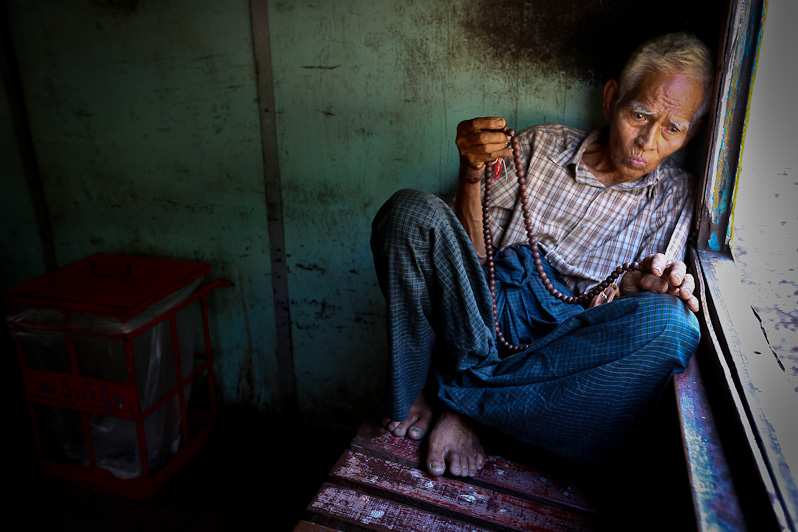
I discovered this gentleman sitting in a train car at Yangon’s central railway station, using Buddhist prayer beads. I liked him, the “patina” on the wall behind him, the color tonality of the scene and the lighting conditions. It seemed like a good combination of a nice subject in ideal light. I approached the man and sat down. Fiddling with my camera for several minutes I occasionally made eye contact and smiled. Eventually I gestured with my camera as if to say “is it OK if I take a photo?”. He nodded, and kept on praying.
I made several exposures with my 16-35 f2.8 lens, trying to use the lead line of the windowsill, but wasn’t able to get the “look” I wanted, so after a while, I slowly stood up and walked several paces backwards. With my 70-200 2.8 I explored a vertical format, this time, trying to use the wooden bench as a lead line. Neither seemed to be giving me results that I liked.
After experimenting with vertical compositions and different focal lengths, I decided to stick with horizontal shots and my 70-200 2.8 and made a series of photographs, paying close attention to his hand positions and the beads, waiting for his hand to be contained on the plain green background of the wall, and in other shots, on the background of his shirt. I also explored options for including and excluding the red trash can on the left side of the frame, hoping to use it to balance things out, although it ended up being a bit too far “offset” from the man’s position to be as effective as I would have hoped.
I also spent a fair amount of time, making different images as he looked out the window, directly at me, and glanced in other directions. Eye position such as direct eye contact versus a more “contemplative” or “pensive” expression made by looking “off camera”, creates a totally difference feel and/or “emotion”.
After perhaps 10 minutes, I had pretty much decided that I had “worked the shot” sufficiently, so I walked back, sat beside him and shared some of the photos I had taken of him. While sitting beside him, I glanced out the window and an idea came to my head….what about shooting him from the outside looking in? After finishing our brief encounter of looking at the images together, I climbed down from the train car to see if there was a good position that might make it possible to get a shot which included him, framed in the window of the train. (to see the results of that, please view my previous blog post by clicking here.)
As for my favorite image of the series; it’s the lead image on this blog post, I’d be interested in your opinion, so if you have a moment, feel free to comment.
Here is the second series of images that I’d like to discuss…..
The following images of a monk praying at Shwedegon Pagoda were made over a period of about 10 to 12 minutes. Like the train shots, I approached the subject first, with my cameras down at my sides, looking intently at his hands and the prayer beads. One of my tour guests was standing with me, so I started to explain about the prayer beads and the lighting situation, occasionally pointing to his hands.
Showing interest in a subject (especially in Myanmar) is a great way to “break the ice”, and in fact, after just a few moments, it was he who established the first contact. He motioned for me to come closer and he spoke a few words of English, asking…”where are you from”?

I told him I was a photography teacher from USA, and introduced him to my “student” (my tour participant). Perhaps he’s a teacher too, and realized that I was explaining something about photography to my “student”; because he became very cooperative, even adjusting his robes so they looked tidy for our photos!
I first chose my 70-200 2.8 and started making pictures of the monk’s hands and the beads, showing them to my tour guest, then to him. This rapport building made all parties comfortable, allowing us to freely work on our photos while he concentrated on his prayers. During a quick review of the photos of his hands, i noticed that the little threads hanging from his prayer beads looked best when contained on a even-toned monochromatic portion of the burgundy robes as a background, rather than a spot where the beads overlapped both deep shadows and brighter spots.
After photographing close ups of the monk’s hands I stepped backwards to create several “environmental shots” made at different focal lengths, which included another monk on the right side of the frame. Using a shallow depth of field, I kept the monk on the right slightly out of focus so that he wouldn’t overly “compete for attention” with the main subject, yet introducing a bit of context and additional interest.
Next, I switched to my 16-35 2.8 and moved in very close, literally placing my camera on the floor in front of the monk. Choosing a low angle perspective gave a completely different look to the image and allowed me to use the gold colored wrought iron railing on the left side of the frame as a lead line and a woman in the doorway on the right side for balance and context.
Before leaving, my we shared some of the pictures on the back of the camera with our subject and parted company having enjoyed another brief interaction with a friendly Burmese monk.


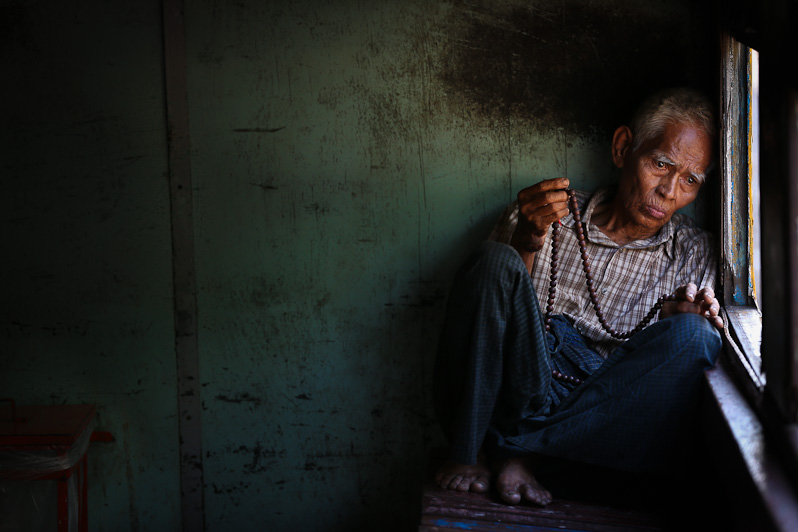
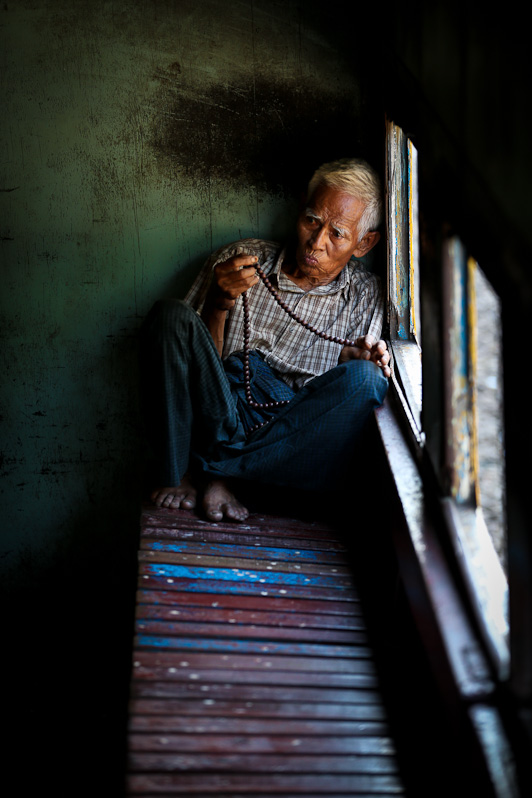

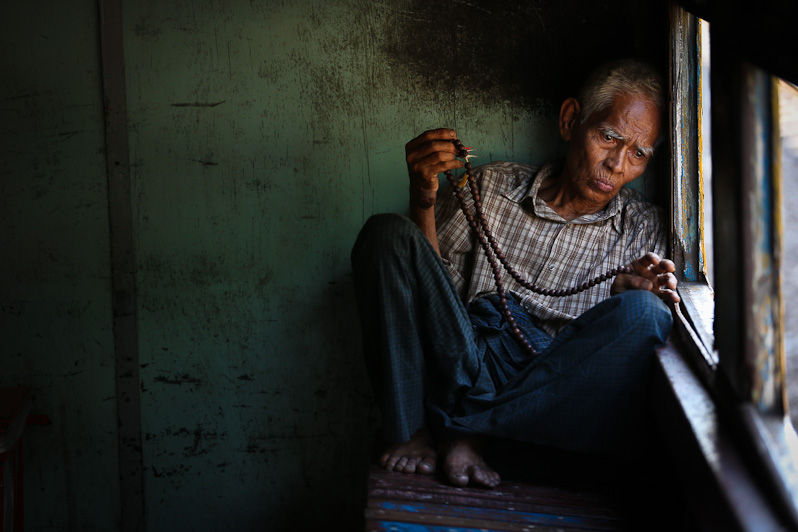

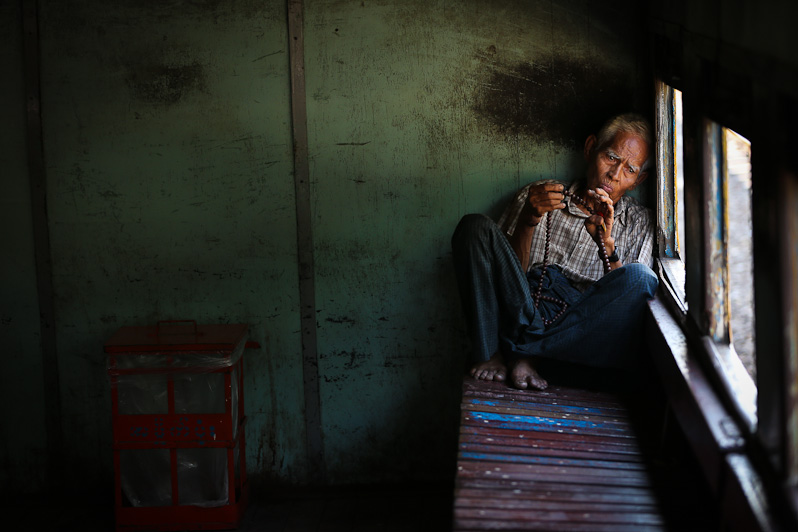
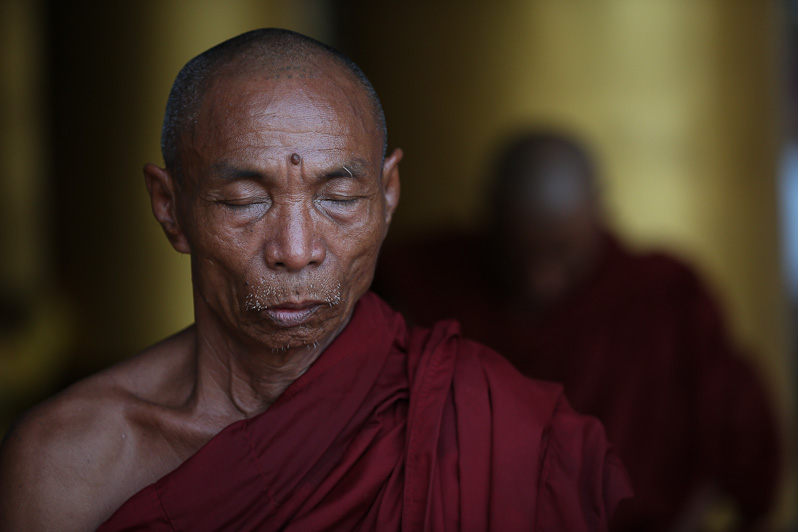
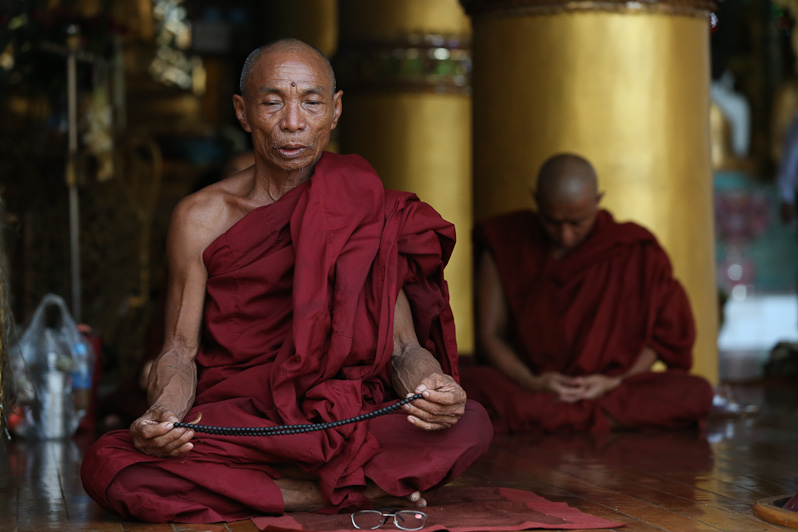







Hi Karl,
Your writing abilities are getting better and better every time. This post was a great lesson, a workshop on itself.
Thanks again my friend.
Celso Mollo
Hi Karl,
How to great to see you explain in your blog how you worked this scene. I learned so much from you on this trip and remember all your excellent instruction as we photographed this monk (a certain distraction notwithstanding). My photography has improved greatly, and I am still in awe of how much you can “see” that the rest of us miss.
Myanmar was fantastic, and I can’t wait to travel with you again.
Best wishes, Zoe
Karl.
The image of the older gentleman in the train was my favorite in your B&W post. I am glad you picked him as a “case study”. Thanks for all these insights as to how to make great images. But I still feel that there something magical about your images that nothing can explained. I am so envious.
Best, France
Great blog and insight on how you work. The lead pix is very strong. It looks like he was in deep thought about a troubling situation. Almost in despair as this to me is a dark themed picture.
Hi Karl
Very interesting; I find that although I am aware of the majority of what you say (and photographer Steve Simon says much the same in his excellent book The Passionate Photographer) I still have to stop mentally and remind myself – whereas the art and skill you have allows much of the process to become second nature rather than conscious thought.
I think this comes with practice as well as, of course, talent. A little like driving – when we learn, we have to think about every little thing but after we have been driving 20 years, we do it all automatically.
My personal choice is the shot from outside the train looking in. It seemed more evocative and atmospheric to my eye – although I’d be pleased to have shot any of them!
Karl, Thank you for sharing friend, thank you for being out there. It seems as though with every new trip, every new story comes a lesson, it does not necessarily need to be a lesson in photojournalism but a lesson in culture, in Life, so huge. I continue working on my small local projects but you friend are showing us the world if we care to pay attention. Thanks Karl.
Cheers, Bill Shirley
Karl,
I think it is wonderful to reinforce the power of human connection when capturing your photos. We know how powerful it is in bringing out emotion for interviews and writing…but it’s great to see how you incorporate it into photography. When we make that connection, for even a moment, it changes the dynamic of that moment because both people are suddenly invested. This post shares one of your most unique secrets! Thank you for sharing!
Anietra
Great info as usual, Karl. What a valuable lesson for all of us to understand, that we “create” great images not “take” them. The combination of light, composition, angles, textures, expressions and color all culminate into an amazing image. This took time and the willingness to experiment. These principles are what make our digital age of photography so amazing!
Thanks for sharing and teaching…it’s what you do so well!
Love how you interact with people, I really admire your work, allow us to see not only the faces of people, but also their souls…Thanks Karl